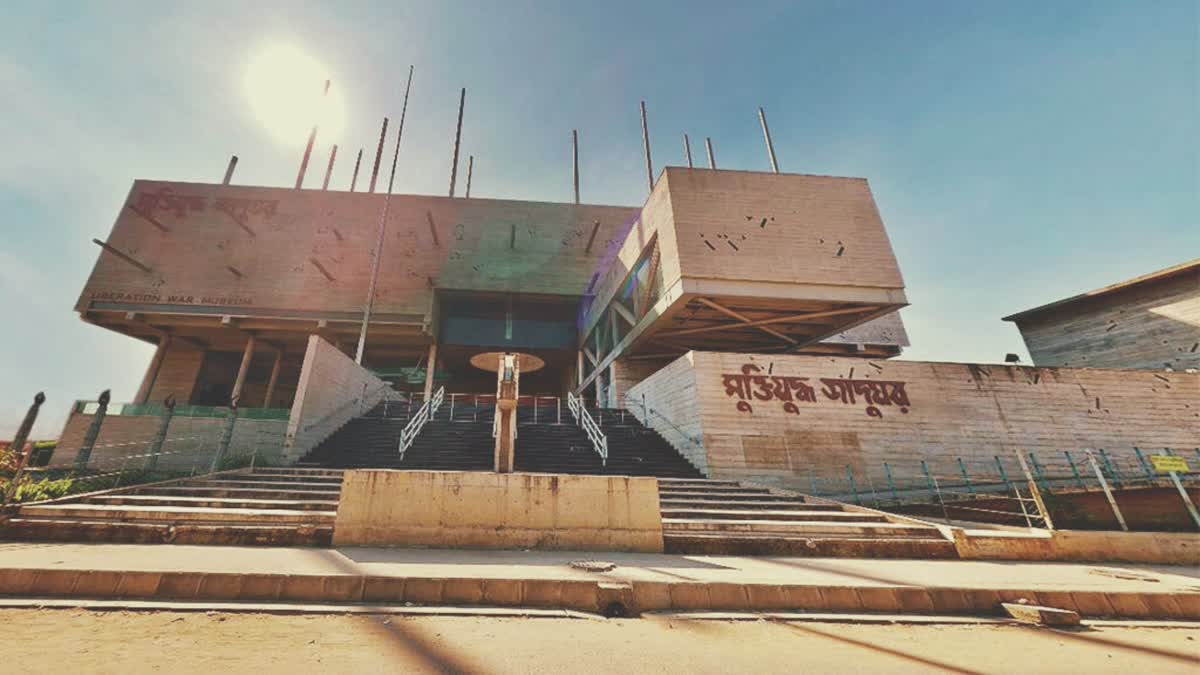The Liberation War Museum in Dhaka, Bangladesh features photographs from the liberation struggle, including one of Sheikh Mujibur Rahman and India's Prime Minister Indira Gandhi. The quote of Sheikh Mujibur Rahman reads, "Great things are achieved through great sacrifice," at the homepage of the website of the museum. This museum is one of the major institutions aimed at ensuring that the stories of India-Bangladesh camaraderie, during the liberation war, are told to the next generation. Students and tourists would visit the museum and watch the film that displays the Pakistan army atrocities against Bangla-speaking people at the time of war. In order to bolster the rebellion against the control of West Pakistan at the time, this movie also showcased India's friendly face. This film highlights the linguistic nationalism in a state where its Constitution identifies itself as an Islamic nation. It also showcases India’s overwhelming support for Bangladesh’s freedom from West Pakistan.
The future generation would get a sufficient idea of India and its involvement in the freedom struggle from this museum's celluloid display. The liberation movie demonstrates India's unwavering support for Mujibur and his comrades against the West Pakistan military. It’s a compelling tale that continued to strengthen the Bangladeshi people's perceptions of India.
The idea behind establishing a museum where a film can be played for visitors was to etch the memories of the liberation struggle in the minds of people. One of the reasons the institution was founded was to remember what people have sacrificed during the struggle. It was primarily established to keep the posterity abreast of what happened during the war and how people faced subjugations and atrocities.
Now that Hasina is gone, her ilk would be wrapping their minds around how it all happened. Nevertheless, they were the ones who penned their own fallout story and exposed it to the public through literature and films. The idea of reintroducing and reinforcing the concept of 'Razakars' who are alleged to have brutalised Bangla-speaking people through espionage and support for Pakistani army was to keep Bangla nationalism alive. The overuse of word 'Razakars' in the nationalist narrative only to demean some opposition members of the country backfired in the recent student protests for the Hasina government. She attributed this disparaging word to the students protesting on streets who grew up watching films of horrors of liberation war. They had been wary of this word ‘Razakar’ their entire lives; therefore, they were unable to digest the derogatory word.
There is a chance that the recent protests and the ensuing change of leadership following Hasina's ouster could destroy every memorial honouring Mujibur's struggle for freedom and the sacrifices made along the way. A key enduring link between India's contribution to the formation of the nation was Hasina's party (Awami League) that is facing existential crisis in the current context. Therefore, symbols of India's involvement in the Bangladesh freedom struggle are at risk. The youth leadership that emerged out of protests against job quotas has written off the older narratives, and protesters have even been spotted demolishing the founder’s statue. This demonstrates the hatred protesting youth have for everything that is a part of Sheikh's family. Sheikhs are a byword for Indian backing for the independence struggle because of the investments India made in the party this family belongs to.
We are essentially seeing history being rewritten and recreated to eclipse the previous one. Witnessing this enormous shift on the ground would make the hearts of those who have made sacrifices sink. India faces enormous challenges in re-establishing its standing as a saviour, as certain quarters view the country as a pariah following a campaign by Indian television channels accusing protestors of inciting communal rioting. India’s foreign policy shift may be needed, especially after Hasina’s refuge in the country after the US and UK shut their doors to her. Is India making the right choice in supporting Hasina over the new dispensation? With a new interim government, India will have to make inroads that allow the free flow of friendly communication that both countries enjoyed for decades.
There is a great possibility of Dhaka taking a different path, one that might not be suitable for India as China's influence may increase in the country. The new generation will remember more what is written on the wall, after the protests, leaving the 1971 war narratives behind. The perspective has shifted as a result of the recent uprising, and a new phase of leadership has completely destroyed the reputation of its predecessors. It was a sort of protest against the families (quota beneficiaries) Mukti Bhainis (Mukhti Jhodas as people generally call them in Bangladesh), who were revered for their sacrifices and served as national heroes supported by India. India provided Mukti Bhainis with support in their battle against the West Pakistan military. Denying India's standpoint and utterly rejecting symbols of the liberation war is the definition of resistance against them. Adjectives for friend and foe, patriot and enemy, were Mukti Bhainis and Razakars. Hasina’s 'Razakars' are running the country and have changed the entire scenario. It was a sucker punch for Awami League as they were caught off guard and could not anticipate the consequences of their misadventure of using derogatory language for protesting youth. The government and the party both paid a high price for the complacency in believing they had complete control over everything in the country. Bangladesh became the second nation in Asia, after Sri Lanka, in which the ruling party family had to flee the country. It will be interesting to see how the situation unfolds in Bangladesh after the Prime Minister, Narendra Modi had a word with interim government’s Chief Advisor, Muhammad Yunus who assured the former that the minorities in the country are protected.



